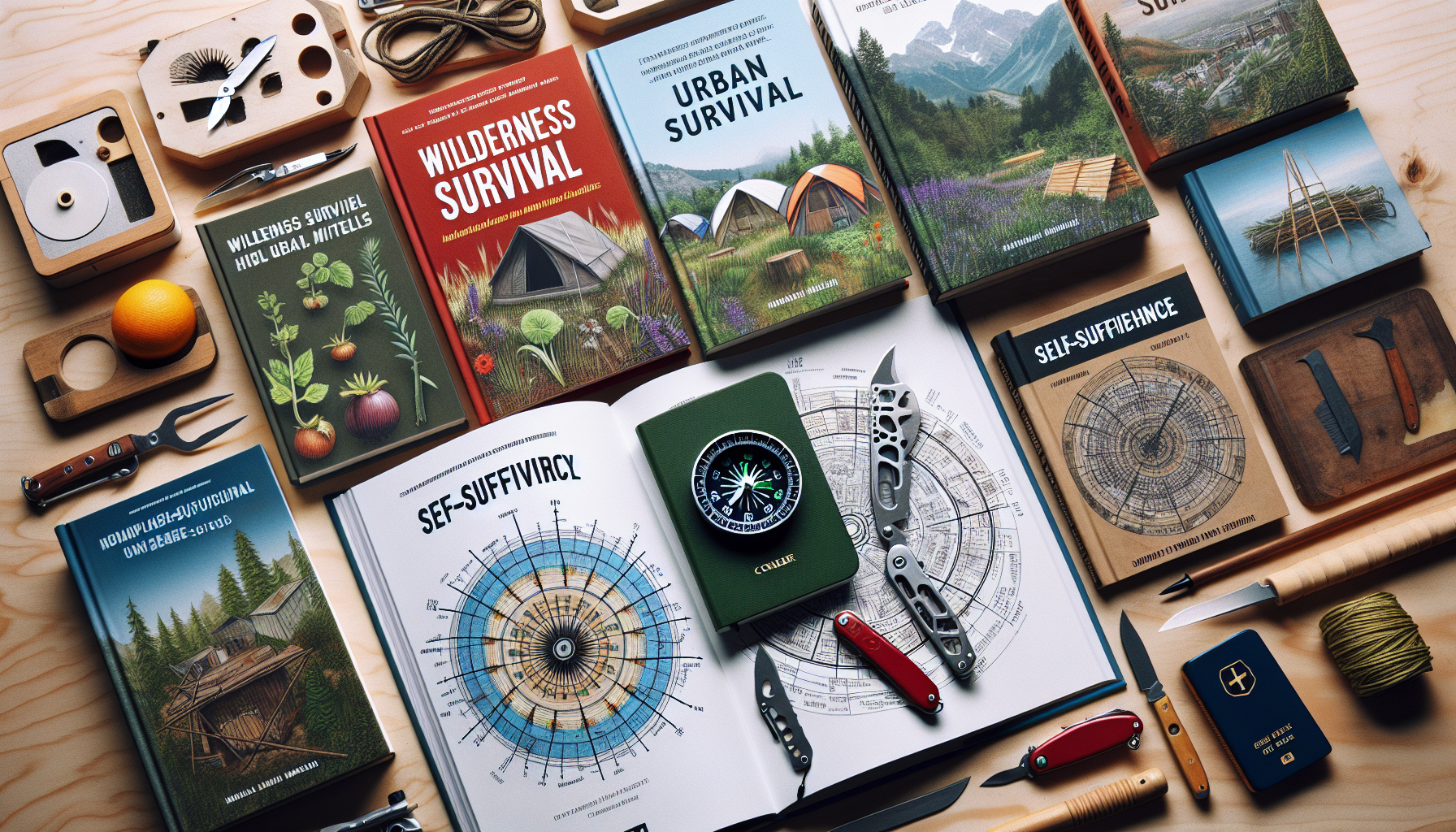In a world filled with uncertainty, being prepared for any situation is essential. Whether you’re an avid adventurer or simply want to be ready for unforeseen circumstances, having access to the best survival books or resources can provide invaluable knowledge and skills. From wilderness survival guides to urban disaster preparedness manuals, these resources offer practical tips, expert advice, and step-by-step instructions to help you navigate through challenging situations. Discover the must-have survival books and resources that will equip you with the necessary tools to face whatever may come your way. When it comes to preparing for emergencies or venturing into the wilderness, having the right knowledge and skills is essential. Whether you’re a beginner or an experienced survivalist, it’s always a good idea to have reliable resources to guide you. In this article, we will explore the best survival books, online resources, survival manuals and guides, wilderness survival skills, survival techniques for disasters and emergencies, survival fiction and non-fiction, edible plant identification and foraging, wilderness medicine and first aid, urban survival skills, and wilderness navigation and orienteering. Let’s dive in and discover some valuable survival resources!
The Best Survival Books
1. “SAS Survival Handbook” by John ‘Lofty’ Wiseman
Considered by many as the ultimate survival guide, “SAS Survival Handbook” covers a wide range of topics, from basic survival skills to more advanced techniques. It provides detailed instructions on building shelters, finding food and water, making fire, and navigating through different terrains. With its practical advice and illustrations, this book is a must-have for anyone interested in survival.
2. “Bushcraft 101: A Field Guide to the Art of Wilderness Survival” by Dave Canterbury
In “Bushcraft 101,” Dave Canterbury explores the art of wilderness survival from a bushcraft perspective. This book focuses on essential skills such as shelter building, firecraft, foraging, and toolmaking. Canterbury’s expertise and clear explanations make this guide accessible to beginners while still offering valuable insights for experienced survivalists.
3. “The Encyclopedia of Country Living” by Carla Emery
If you’re preparing for a long-term self-sufficient lifestyle, “The Encyclopedia of Country Living” is a comprehensive resource you don’t want to miss. Covering a wide range of topics, including gardening, raising livestock, food preservation, and alternative energy sources, this book is a treasure trove of knowledge for those seeking to live off the grid.
4. “Wilderness Survival” by Gregory J. Davenport
Gregory J. Davenport’s “Wilderness Survival” is a trusted resource that provides practical advice on surviving in various outdoor environments. From extreme cold to desert heat, this book equips you with the knowledge and skills needed to thrive in challenging wilderness scenarios. It covers topics such as shelter construction, water procurement, and signaling for help.
5. “98.6 Degrees: The Art of Keeping Your Ass Alive” by Cody Lundin
Cody Lundin, an experienced survival instructor, presents a unique approach to survival in “98.6 Degrees.” With a focus on urban and wilderness survival techniques, this book emphasizes the importance of maintaining core body temperature, as well as practical skills like fire making, finding and purifying water, and navigating your surroundings.
Online Survival Resources
1. The Survivalist Blog (www.thesurvivalistblog.net)
The Survivalist Blog is a treasure trove of survival-related articles, tips, and discussions. Created by M.D. Creekmore, a long-time prepper and survivalist, this blog covers a wide range of topics, including food storage, self-defense, and sustainable living. With its active community and wealth of information, this website is a valuable resource for anyone looking to enhance their survival skills.
2. Survivopedia (www.survivopedia.com)
Survivopedia is an online survival magazine that provides readers with regular articles on disaster preparedness, homesteading, and self-defense. The website offers a diverse range of content, including how-to guides, product reviews, and survival stories. Whether you’re a beginner or an advanced survivalist, you’ll find practical tips and insights to help you navigate different scenarios.
3. Outdoor Life (www.outdoorlife.com/survival)
Outdoor Life, a renowned magazine for outdoor enthusiasts, has an extensive section dedicated to survival. From articles on wilderness survival skills to gear recommendations, this website covers a wide array of topics in a user-friendly format. Whether you’re interested in hunting, fishing, or bushcraft, Outdoor Life’s survival section has something for everyone.
4. The Prepper Journal (www.theprepperjournal.com)
The Prepper Journal is a comprehensive online resource for preppers and survivalists. This website covers a vast range of topics, including food storage, emergency preparedness, and self-defense. With its detailed articles, gear reviews, and survival tips, The Prepper Journal serves as a valuable guide for those seeking to enhance their survival skills and be ready for any emergency.
5. Graywolf Survival (graywolfsurvival.com)
Graywolf Survival, run by former military and law enforcement personnel, offers a wealth of information on survival and emergency preparedness. From comprehensive gear reviews to step-by-step survival guides, this website provides valuable insights into surviving in diverse environments. Graywolf’s emphasis on practicality and real-world scenarios makes it a go-to resource for survival enthusiasts.

Survival Manuals and Guides
1. US Army Survival Manual
The US Army Survival Manual, also known as FM 3-05.70, is a comprehensive guide that covers all aspects of survival in various environments. It provides information on first aid, navigation, shelter construction, and food procurement. Written with clarity and filled with illustrations, this manual is a valuable resource for anyone interested in survival skills.
2. US Air Force Survival Handbook
The US Air Force Survival Handbook, also known as AF Regulation 64-4, offers a wealth of survival knowledge tailored to aircrews and personnel. It covers a range of topics, including shelter building, water procurement, signaling, and psychological aspects of survival. This handbook provides valuable insights into surviving in adverse situations, whether on land or at sea.
3. US Marine Corps Survival Handbook
The US Marine Corps Survival Handbook, also known as MCRP 3-02F, is a comprehensive guide specifically designed for Marines. This handbook covers essential survival skills and techniques, including navigation, signaling, and food procurement. With its emphasis on adaptability, resilience, and resourcefulness, this manual is a valuable resource for anyone seeking to enhance their survival knowledge.
4. Boy Scouts of America Fieldbook
The Boy Scouts of America Fieldbook is a comprehensive resource for both scouts and outdoor enthusiasts. It covers a wide range of topics, including wilderness survival skills, first aid, and nature conservation. With its practical guidance and informative illustrations, this fieldbook equips readers with the necessary skills to navigate the outdoors safely.
5. FEMA’s “Are You Ready?” Guide
FEMA’s “Are You Ready?” guide is a comprehensive resource published by the Federal Emergency Management Agency. This guide covers various types of disasters and emergencies, providing guidance on preparedness, response, and recovery. From creating an emergency plan to assembling a disaster supply kit, this guide offers practical advice for individuals and families.
Wilderness Survival Skills
1. Building Shelter
Building a reliable shelter is crucial for survival in the wilderness. Understanding different shelter types, such as lean-tos, debris huts, and tarp shelters, can make a significant difference in protecting yourself from the elements. Learning how to select a suitable location, gather materials, and construct a sturdy shelter is a fundamental skill every wilderness adventurer should possess.
2. Starting a Fire
Fire provides warmth, light, and the ability to cook food and purify water. Mastering fire-making techniques using various methods such as friction, sparks, or chemical ignition can be a lifesaver in a survival situation. Understanding fire safety and knowing which materials to use for tinder, kindling, and fuel are essential skills for staying warm and safe in the wild.
3. Finding and Purifying Water
Water is a basic necessity for survival, and knowing how to find and purify it in the wilderness is crucial. Understanding how to locate water sources, collect water, and purify it through methods such as boiling, filtering, or chemical treatment can help prevent dehydration and waterborne illnesses. Learning these skills will ensure your ability to stay hydrated and healthy in any survival scenario.
4. Hunting and Trapping
Knowing how to procure food through hunting and trapping is an essential wilderness survival skill. Understanding animal behavior, tracking techniques, and setting effective traps can increase your chances of securing a source of sustenance. It’s important to learn about local wildlife, edible plants, and ethical hunting practices to ensure minimal environmental impact while providing for your survival.
5. Navigation and Orienteering
Navigating through unfamiliar terrain is a crucial skill for wilderness survival. Learning how to read topographic maps, use a compass, and identify landmarks can help you maintain a sense of direction and avoid getting lost. Additionally, developing basic orienteering skills, such as interpreting sun and star positions or using GPS devices, can contribute to your overall wilderness navigation abilities.

Survival Techniques for Disasters and Emergencies
1. First Aid and Medical Skills
Having basic first aid and medical skills is vital for survival in emergencies. Knowing how to provide CPR, treat wounds, immobilize fractures, and recognize the signs of common medical emergencies can make a significant difference in ensuring the well-being of yourself and others. Consider taking a first aid course or referring to comprehensive survival medical guides to prepare yourself for unforeseen circumstances.
2. Food Storage and Preservation
In disaster scenarios, having a reliable food supply is crucial. Learning effective food storage and preservation techniques, such as canning, dehydrating, or fermenting, can help extend the shelf life of perishable items and maximize available resources. Understanding proper food rotation and the use of alternative food sources, such as foraging or fishing, can contribute to long-term self-sufficiency.
3. Communication in Crisis
During emergencies, communication is essential for coordinating efforts and seeking help. Knowing various communication methods, such as using radios, signal mirrors, or improvised devices, can facilitate contact with rescuers or fellow survivors. Additionally, understanding how to transmit distress signals and navigate emergency communication channels can significantly increase the chances of a successful rescue or evacuation.
4. Self-defense and Security
In times of crisis, personal safety and security become paramount. Learning self-defense techniques and situational awareness can help protect yourself and your loved ones from potential threats. Understanding home security measures, creating safe zones, and developing effective self-defense strategies are essential survival skills in urban or rural environments.
5. Psychological Preparedness
Survival is not just about physical skills; mental and emotional resilience are equally important. Developing coping mechanisms, stress management techniques, and maintaining a positive mindset can greatly enhance your survival capabilities. Understanding the psychological effects of crises and practicing self-care strategies can help you stay focused, calm, and motivated in challenging situations.
Survival Fiction and Non-Fiction
1. “The Road” by Cormac McCarthy
“The Road” by Cormac McCarthy is a powerful portrayal of a post-apocalyptic world. This gripping novel follows a father and son as they navigate a desolate landscape, struggling to find food, shelter, and safety. McCarthy’s vivid prose and exploration of human resilience make this book a must-read for those interested in survival fiction.
2. “Hatchet” by Gary Paulsen
“Hatchet” is a beloved young adult novel that tells the story of Brian Robeson, a thirteen-year-old boy stranded in the Canadian wilderness after a plane crash. As Brian learns to survive with only a hatchet to help him, readers are taken on a transformative journey of self-discovery and resourcefulness. This engaging book is perfect for young readers and adults alike.
3. “One Second After” by William R. Forstchen
“One Second After” offers a chilling glimpse into the aftermath of an electromagnetic pulse (EMP) attack on the United States. The novel follows John Matherson, a small-town professor, as he struggles to protect his community and navigate a world plunged into chaos. This thought-provoking book explores the fragility of modern society and the resilience of the human spirit.
4. “The Martian” by Andy Weir
“The Martian” is a thrilling science fiction novel that follows astronaut Mark Watney’s struggle to survive after being stranded alone on Mars. Faced with limited resources and formidable challenges, Watney must use his ingenuity and scientific knowledge to stay alive. This gripping tale of survival against all odds will captivate readers and ignite their sense of exploration.
5. “Alas, Babylon” by Pat Frank
Set during the Cold War era, “Alas, Babylon” paints a vivid picture of a small Florida town struggling to survive in the aftermath of a nuclear war. As the community bands together to overcome scarcity, conflict, and the threat of radiation, Pat Frank’s novel serves as a reminder of the power of community and resourcefulness in times of crisis.

Edible Plant Identification and Foraging
1. “A Field Guide to Edible Wild Plants” by Lee Allen Peterson
“A Field Guide to Edible Wild Plants” is a handy resource for identifying and foraging edible plants in North America. With detailed descriptions, photographs, and tips on preparation, this field guide empowers readers to safely and confidently explore wild edible options. It provides valuable knowledge on finding nourishment in the natural world.
2. “Edible Wild Plants: A North American Field Guide” by Thomas Elias
Thomas Elias’s “Edible Wild Plants” is a comprehensive guide that covers over 200 North American species, including plants found in different habitats and seasons. The book includes information on each plant’s edible parts, preparation methods, and potential look-alikes to avoid. With its extensive coverage and clear illustrations, this guide is an excellent companion for foragers.
3. “Foraging: A Guide to Discovering Delicious Edible Wild Plants and Fungi” by Paul Chambers
“Foraging” by Paul Chambers is a beginner-friendly guide to discovering delicious edible plants and fungi. Covering a wide range of species, this book offers practical tips on harvesting, preparation, and even recipes for your foraged finds. Whether you’re interested in wild greens, mushrooms, or berries, this guide will help you safely and sustainably enjoy nature’s bounty.
4. “Backyard Foraging: 65 Familiar Plants You Didn’t Know You Could Eat” by Ellen Zachos
If urban foraging is more your style, “Backyard Foraging” is the perfect resource. Focusing on commonly found plants, this book shows readers how to identify and use edible species right in their own neighborhoods. Ellen Zachos shares her expertise on urban foraging, providing insights into finding edible plants in unexpected places and incorporating them into your meals.
5. “The Forager’s Harvest: A Guide to Identifying, Harvesting, and Preparing Edible Wild Plants” by Samuel Thayer
“The Forager’s Harvest” offers comprehensive information on identifying, harvesting, and preparing over 50 wild edible plants. Samuel Thayer’s in-depth knowledge and detailed descriptions make this book a valuable resource for foragers of all skill levels. With its emphasis on sustainable practices and accurate plant identification, this guide promotes a deeper understanding of nature’s edible treasures.
Wilderness Medicine and First Aid
1. “Medicine for the Outdoors: The Essential Guide to First Aid and Medical Emergencies” by Paul S. Auerbach
“Medicine for the Outdoors” is a comprehensive guide to wilderness medicine and first aid by renowned expert Paul S. Auerbach. This book covers a wide range of topics, including trauma management, altitude sickness, snake bites, and medical kit essentials. With its practical advice and easy-to-follow instructions, it is an invaluable resource for anyone venturing into remote areas.
2. “Wilderness Medicine: Beyond First Aid” by William W. Forgey
“Wilderness Medicine: Beyond First Aid” offers readers a deeper understanding of wilderness medical emergencies and their management. Dr. William W. Forgey provides insights into topics such as altitude illness, hypothermia, and wilderness trauma care. This comprehensive guide equips readers with the knowledge needed to address medical issues when professional help is not readily available.
3. “NOLS Wilderness Medicine” by Tod Schimelpfenig and Joan Safford
“NOLS Wilderness Medicine,” written by experts from the National Outdoor Leadership School (NOLS), provides a comprehensive guide to dealing with medical emergencies in remote settings. It covers a broad range of topics, including patient assessment, wound care, and improvised techniques. With its practical approach and clear illustrations, this book is an essential reference for outdoor enthusiasts and professionals alike.
4. “The Survival Medicine Handbook: A Guide for When Help is Not on the Way” by Joseph Alton and Amy Alton
“The Survival Medicine Handbook” is a comprehensive guide to managing medical emergencies in disaster or survival scenarios. Dr. Joseph Alton and Amy Alton provide essential information on recognizing and treating a wide range of injuries and illnesses when professional medical care is unavailable. With its practical advice and emphasis on resourcefulness, this handbook is a valuable addition to any survivalist’s library.
5. “Bushcraft First Aid: A Field Guide to Wilderness Emergency Care” by Dave Canterbury
“Bushcraft First Aid” focuses on providing first aid skills specifically tailored to wilderness environments. Written by outdoor expert Dave Canterbury, this field guide covers topics such as wound care, fractures, and environmental emergencies. With its emphasis on improvisation and minimal resources, this book equips readers with the knowledge needed to provide effective medical care in remote locations.

Urban Survival Skills
1. Home Security and Defense Strategies
Urban survival requires specific skills to ensure personal safety and security. Learning home security measures, such as reinforcing doors and windows, setting up alarm systems, and securing essential supplies, can help protect yourself and your loved ones in urban environments. Understanding self-defense techniques and situational awareness is also crucial for personal safety.
2. Emergency Water and Food Storage in Apartments
In urban settings, space constraints often pose challenges for storing emergency supplies. Knowing how to efficiently store water and non-perishable food in small apartments can make a significant difference in your overall preparedness. Learning about alternative water sources and the use of compact food storage solutions can maximize your available resources.
3. Essential Tools and Supplies for Urban Survival
Having the right tools and supplies is essential for urban survival. Understanding which items are crucial for your emergency kit, such as flashlights, multi-tools, and portable water filters, can help you navigate through crises effectively. It’s important to prioritize versatile and lightweight gear that can address various survival needs in an urban environment.
4. Escape and Evasion Techniques
In certain urban survival scenarios, knowing how to escape and evade potential threats becomes essential for personal safety. Learning escape and evasion techniques, such as lock picking, discreet movement, and concealment strategies, can provide you with an added advantage when faced with dangerous situations. These skills can enhance your ability to navigate urban areas discretely and avoid potential harm.
5. Urban Gardening and Sustainable Living
Even in urban environments, it’s possible to maintain self-sufficiency through urban gardening and sustainable living practices. Learning about container gardening, vertical farming, and small-space composting can help you grow your food and reduce your ecological footprint. Understanding the principles of permaculture and implementing sustainable practices can contribute to a long-term urban survival strategy.
Wilderness Navigation and Orienteering
1. Map Reading and Topographic Maps
Understanding how to read and interpret maps is an essential skill for wilderness navigation. Learning to identify key features, read contour lines, and create mental imagery using topographic maps can help you navigate through various terrains. Practicing map reading skills regularly and familiarizing yourself with different map types can greatly enhance your ability to find your way in the wild.
2. Using a Compass and Navigation Techniques
A compass is a valuable tool for wilderness navigation, and knowing how to use it effectively is key. Learning to orient a map, take accurate bearings, and use different navigation techniques like dead reckoning or triangulation can help you stay on track and reach your intended destination. Regular compass practice and understanding magnetic declination are vital for accurate navigation.
3. GPS Navigation and Geocaching
Global Positioning System (GPS) devices are widely accessible and offer a reliable means of wilderness navigation. Learning how to use GPS devices effectively, including setting waypoints, navigating to coordinates, and understanding accuracy limitations, can enhance your wilderness navigation skills. Exploring geocaching, a treasure-hunting outdoor activity, can provide practical experience in using GPS technology in real-world scenarios.
4. Celestial Navigation and Star Identification
In certain situations, celestial navigation can be vital for wilderness orientation. Understanding how to identify stars and constellations, measure angles, and calculate time using celestial bodies can help you determine direction, approximate latitude, and track the passage of time, even without modern navigation tools. Learning basic celestial navigation can be a valuable backup method for wilderness navigation.
5. Landmarks and Natural Navigation Methods
Landmarks and natural features can serve as reliable navigation aids in the wilderness. Learning to identify distinctive landmarks, read the landscape, and utilize natural navigation methods, such as sun shadows or prevailing wind directions, can assist in finding your way. Cultivating your observation skills and developing a keen sense of your surroundings will enhance your ability to navigate intuitively.


